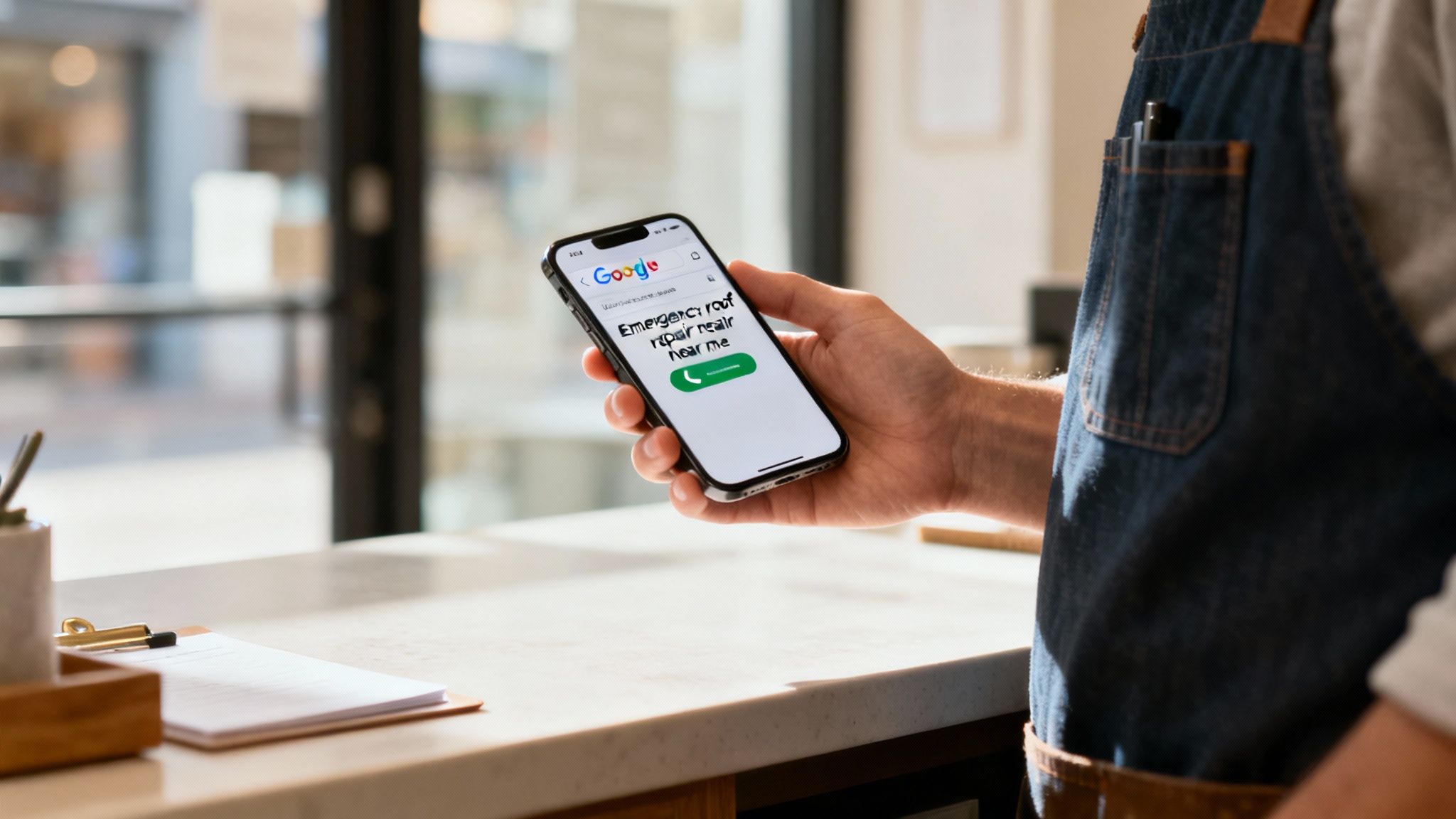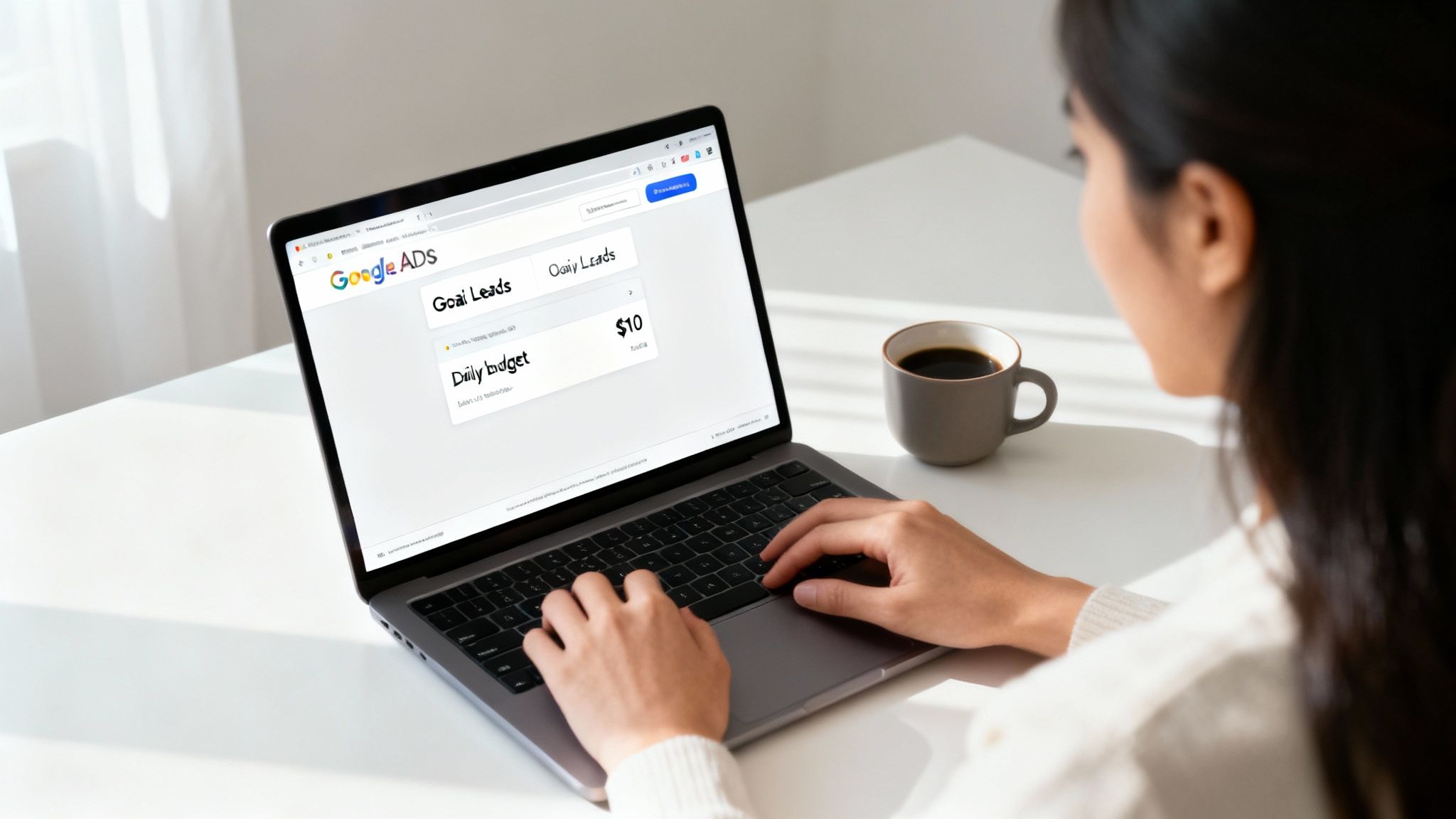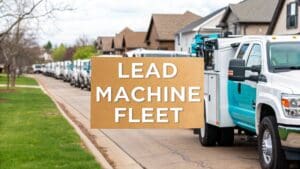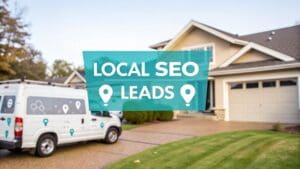Ever feel like Google Ads is some super-secret club, and only tech wizards have the password? It’s okay, most people do. It can look pretty intimidating.
But I’m going to let you in on a little secret: super simple Google Ads are real. You can actually use them to get more customers, and it’s way easier than you think. You can do this. Seriously.
Yes, You Can Actually Do This. I Promise.
If you can run your own business, you can totally run a simple Google Ads campaign. Forget all those confusing charts and buttons that look like they could launch a rocket.
Think of this guide as your treasure map. I’m going to show you how a simple website and a small, smart ad budget can become your best friend for getting new leads.
The only goal here? Making your phone ring. That’s it.
People are already on Google every single day looking for exactly what you sell. Your job isn’t to talk them into wanting your service. It’s just to wave a big, friendly sign in front of them the second they’re ready to buy.
Why Google Is Where the Customers Are
This all works for one simple reason: your grandma uses Google, your nephew uses Google, pretty much everyone uses Google. It’s not just a search engine; it’s the search engine. It’s like the town square of the internet.
This is what the Google Ads platform looks like—it’s your control panel for getting in front of all those people.

This tool is built to connect your business with the millions of people searching on Google every day.
The number of people using it is just wild. It’s like trying to count all the squirrels in the world. By 2025, Google will have about 90.06% of all the people searching online. That means your customers are practically guaranteed to be there, right now, looking for you.
And it’s not just on the search page. Google’s ads can pop up on over 90% of all websites on the internet. It’s a huge audience just waiting to find you.
The best part? You don’t need a fancy marketing degree or a giant pile of cash to play. All you need is a clear plan and the courage to take the first step. That’s what we’re going to do right now. You can do this.
Your Website Is Your Star Player
Before you spend a single penny on ads, please tattoo this on your brain: your ad makes a promise, but your website has to deliver on it.
A simple, clean website that makes it crazy easy for people to call you or fill out a form is what turns a click into a real, paying customer. This is a must-have. A bad website is like having a beautiful storefront with a door that’s boarded up.
This is where everything comes together. A good website, a visible Google Business Profile, and a simple ad campaign all work as a team. Getting your online house in order is step one. You can learn exactly how by checking out our guide on how to optimize your Google Business Profile.
Building Your First Ad Campaign (Without the Headaches)
Alright, let’s roll up our sleeves and build your first campaign. I promise this isn’t as scary as doing your taxes. You’re about to see just how much control you have. This is where we build your simple machine that spits out new leads.

We’re going to nail just three things: your goal, your budget, and where your customers live. Get these right, and you’ll have a campaign that brings in calls instead of confusion.
Your Goal: Just Get More Leads
When Google Ads asks you what you want to do, don’t get lost in all the choices. For almost every local business I’ve ever helped, the answer is the same: you want more leads. That’s it.
A “lead” is just a fancy word for someone who actually reaches out to you. They might:
- Call your business phone number.
- Fill out the contact form on your website.
- Ask you for a price on a job.
By choosing “Leads,” you’re telling Google, “Hey, don’t just show my ad to people who are bored. Show it to people who are likely to actually call me.” This one choice helps the whole system focus on what really makes you money.
Your Budget—You’re the Boss
Now for the part that makes everyone nervous—the money. How much should you spend? The honest answer is to start with an amount you are 100% comfortable with, even if it feels tiny.
Think of it as your daily coffee money. Can you spare $10 or $15 a day to see what happens? That’s a perfect place to start. You set a daily budget, and Google will never spend more than that amount times the days in the month.
You are the boss of your budget. If you want to spend $5 a day, you can. If you want to stop your ads after three days, you can. You have a volume dial, not some scary on/off switch you can’t find.
This is your money. A small daily budget lets you see what happens in the real world without taking a big risk. Once you see the calls coming in, you can feel good about turning up the dial. This is the exact smart, simple way we show how local businesses can turn on ads that actually bring in customers.
Find Your Local Customers (The Most Important Part)
This next step is so important, but so simple. You have to tell Google exactly where your customers are. If you’re a plumber in Phoenix, you don’t want someone in Alaska seeing your ad. That’s just throwing your coffee money into a volcano!
Get specific here. You can pick your city, a few zip codes, or even draw a little circle around your business address. This makes sure every single penny is spent trying to reach people who can actually hire you.
By focusing on your service area, you make your small budget work way harder, connecting you right to the local folks who need you most.
To help you remember these key pieces, I’ve made a quick checklist. Look this over before you press the “Go” button.
Your Super Simple Checklist
This table is your pre-launch check to make sure you’ve covered the basics for a campaign built to get you leads, not just clicks.
| Checklist Item | Why It Matters | What to Do |
|---|---|---|
| Pick a Clear Goal | Tells Google to find people who will contact you, not just look around. | Choose the “Leads” goal when you set up the campaign. |
| Set a Comfy Budget | Stops you from overspending and lets you test things out safely. | Set a daily budget of $10-$20 that you won’t lose sleep over. |
| Target Your Town | Stops you from wasting money on clicks from people you can’t help. | Enter your city, main zip codes, or a 15-20 mile circle around your address. |
| Turn On Tracking | This is how you know if the ads are actually working (getting you calls/forms). | Make sure you’ve set up tracking for phone calls and contact forms. |
| Add “Don’t Show” Words | Stops your ad from showing up for silly searches like “jobs” or “how to do it yourself.” | Add words like “free,” “hiring,” “school,” and “how to” to your negative keyword list. |
Following this simple list gets you 90% of the way there. It cuts out all the confusing stuff and focuses your time and money on what will actually make the phone ring.
Finding Words That Bring In Real Customers
Let’s talk about “keywords.” This is another one of those words that sounds complicated, but it’s not. A keyword is just the words a real person types into Google when they need what you sell. You don’t need a giant, confusing list with a thousand phrases. You just need to pretend you’re your customer for a minute.
Imagine your roof just started leaking during a big rainstorm. You grab your phone. What do you type into Google?
You’re not looking up “advanced roofing materials.” You’re frantically typing in “emergency roof repair near me” or “leaky roof fix Phoenix.”
Those are pure gold. Those are words full of need. The person searching isn’t just looking around; they have a big problem right now and are looking for a hero to fix it. That’s you. This simple exercise is the secret to a super simple Google Ads campaign that actually works.
Think Like Your Customer, Not a Salesperson
Honestly, your best keywords come from common sense, not some fancy, expensive computer program. Just take a second and think of a few “I need help now” phrases for your own business.
- Plumber? Think “clogged drain service” or “hot water heater broken.”
- House Cleaner? Try “help cleaning my house” or “deep cleaning for home.”
- Accountant? It’s probably “help with small business taxes” or “accountant near me.”
See what I mean? You’re just putting yourself in their shoes. These are the exact phrases that lead directly to phone calls and real jobs. For more ideas for your type of business, check out our guide on Google Ads for local businesses, which digs deeper into finding these magic words.
Meet Your Ad’s Bouncer: Negative Keywords
Now for the secret weapon that saves you a ton of money: negative keywords. Think of these as the bouncer for your ad campaign. Their job is simple: stand at the door and kick out anyone who isn’t a real customer.
You’re just telling Google, “Hey, if someone searches for this word, do NOT show them my ad.” It’s super powerful.
Let’s say you repair fences. You want to show up for “wood fence repair.” But you don’t want to waste money on people searching for “how to repair wood fence myself” or “fence repair jobs.” Those people are looking for instructions or a job—not to hire you.
Adding words like “DIY,” “jobs,” “hiring,” “free,” and “school” to your negative keyword list instantly filters out the people who won’t pay you. Your ad money goes way further because it’s only spent on people who are actually looking to write you a check.
This isn’t some complex, expert-level trick. It’s just a simple list of words you make to protect your wallet. Finding the right words is less about being a tech genius and more about common sense—putting you right in front of people who are ready to buy. You can do this.
Writing Simple Ads People Actually Click On
Your Google Ad is like the sign in your shop window. Is it friendly? Does it solve a problem right away? Good news—you don’t need to be a famous writer to create an ad that works.
The whole secret to a super simple Google Ads campaign is writing an ad that’s helpful, not just another pushy sales pitch.
Let’s be real: nobody likes being sold to, but everyone loves having their problems solved. That’s our only goal here. We’re going to focus on three simple parts that make a great ad. Think of it as a recipe for getting clicks from real, local customers.
The Simple Ad Recipe
Your ad only needs three ingredients to work. Let’s break them down without any of the confusing stuff.
- A Headline That Says “Yoo-hoo! Over here!”: This is the first thing people see, and it has to match what they just searched for. If they typed in “emergency plumber,” your headline needs to say something like “Fast Emergency Plumbing Service.” You’re just waving and saying, “Yep, you’re in the right place!”
- A Description That Shows the Happy Ending: Don’t just list what you do; talk about how it helps them. Instead of saying, “We use high-quality mowers,” try “Get a Perfect Lawn, Every Time.” It’s not about your tools; it’s about their beautiful yard.
- Tell Them What to Do Next: Don’t be shy. Tell them exactly what to do next. Simple phrases like “Call for a Free Quote” or “Book Your Cleaning Online” are direct, clear, and they work.
Here’s a quick fill-in-the-blank recipe: [Solve Their Problem]. [Explain the Happy Result]. [Tell Them What to Do].
For a lawn care business, this could be: “Reclaim Your Weekends. Get a Perfect Lawn Without the Work. Get a Free Quote Today!” See how simple that is? You can absolutely do this.
It’s no surprise that around 65% of small and medium-sized businesses run these kinds of ads. They’ve figured out it’s a direct phone line to customers who are ready to buy, which is why a big piece of their ad money goes to Google.
Don’t Send People to Your Homepage
This next tip is so important it could make or break your whole plan. Never, ever send people who click your ad to your website’s homepage.
Think about it. Someone just clicked your ad for “leaky roof repair” because water is dripping on their TV. They need help now. Don’t make them go on a scavenger hunt through your homepage, clicking on “About Us” and scrolling through a big list of services.
Send them directly to a page that is all about fixing leaky roofs. That’s it.
That page should have your phone number in big, bold letters at the top, along with a simple contact form. Make it unbelievably easy for them to get in touch with you. This one small change turns more clicks into paying customers than almost anything else.
This same idea works for everything, not just Google. We talk about this in our guide to Facebook ads for local business owners, too. And to make sure your ads look great, it’s worth learning how to create AI video ads that convert.
If you ever feel stuck on this stuff, that’s why we’re here. We can help you write these simple ads and make sure they point to the right spot on your website—turning your ad money into real business.
So, Are Your Ads Actually Working?
Alright, you’ve got ads running. Give yourself a pat on the back! But now for the big question: how do you know if you’re making money or just making Google richer?
This is where most people get lost in confusing reports and weird charts. Forget all that. We’re going to keep this super simple and focus on just one thing: conversion tracking.
It sounds technical. It’s not.
A conversion is just the main thing you want a customer to do. For almost every local business, that means one of two things:
- Someone calls your business from the ad.
- Someone fills out the contact form on your website.
That’s it. Think of it as the scoreboard for your ads. You’re not counting clicks; you’re counting real people who could become paying customers.
Setting Up a Simple Scoreboard
Getting this set up is way easier than it sounds. Google can keep track of when someone clicks the call button on your ad or when they land on your “Thank You” page after filling out a form. This shows you exactly which ads are making your phone ring.
Honestly, figuring out what conversion tracking is is the whole game. It’s the difference between guessing and knowing. Without it, you’re just throwing money in a wishing well and hoping for the best.
Once you have this working, you can see for sure whether your ad money is a good investment or just a cost. This isn’t just wishful thinking; the numbers prove it.
Google’s own data shows that for every $1 a business spends on their ads, they make an average of $8 in profit. That’s like putting a dollar in a machine and getting eight dollars back! And it’s all possible because you know which ads are doing the heavy lifting.
Your 5-Minute Weekly Check-In
You don’t need to stare at your Google Ads account all day. In fact, please don’t. Just set aside five minutes, once a week, to look at two or three key numbers.
Here’s your quick check-up:
- How many leads (conversions) did I get? Is your phone ringing more? Are you getting more emails from your website? This is the only number that really matters.
- What did each lead cost me? Just divide how much you spent by the number of leads you got. If you spent $100 and got 5 leads, each one cost you $20. Is a $20 lead worth it for your business? If the answer is yes, you’re winning.
This simple check-in keeps you in charge. It tells you what’s working so you can do more of it, and what’s not so you can stop wasting money. It’s so important that we include it in our small business SEO checklist because it applies to everything you do online.
If keeping track of this feels like one more thing on your giant to-do list, don’t worry. This is exactly what we help business owners with every day. We can set up this simple scoreboard for you and show you how to read it, so you always know your ads are bringing in real customers.
Your Google Ads Questions, Answered
Got a few more questions rattling around in your head? Good. That means you’re being smart about this. Let’s clear up the most common ones right now with some simple, straight answers.
You can absolutely make super simple Google Ads work. Getting these last few things straight will give you the confidence to get it done.
How Much Money Should I Start With?
Start small. I really mean it. Think of your first ad budget as a small experiment, not a giant commitment.
For most local businesses, $10-$20 a day is a great starting point. That’s more than enough to start getting some real clicks and see what’s working without risking a bunch of money.
The whole point is to be steady. Once you see calls coming in and you know you’re making money from the ads, then you can feel good about spending a little more. You’re always in control and can press the pause button whenever you want.
What’s More Important: A Fancy Ad or a Good Website?
Your website is the star of the show. It’s not even close.
Think of it this way: your ad is the invitation to the party, but your website is the party. You can have the world’s best invitation, but if it sends people to a slow, confusing, or broken website, you just wasted your money. People will leave.
A simple, fast website that makes it super easy for someone to call you or fill out a form is what turns clicks into paying jobs. It’s the most important piece of the whole puzzle.
The funniest, most creative ad on the planet can’t save a bad website. Focus on a clear headline, a simple contact form, and putting your phone number right at the top of the page.
How Long Until I See Results?
This is the best part—it’s fast. Way faster than almost any other type of marketing. You can start seeing people click and visit your website within a few hours of your ad going live.
Now, getting actual leads—phone calls and filled-out forms—usually takes a few days to a week. The system needs a little time to learn who your best customers are and where to find them.
The trick is to have a little patience that first week. Don’t panic and start changing everything every day. Just let it run and learn. Then you can start making small, smart changes based on what you’re seeing.
Do I Really Need to Hire Someone to Do This?
Nope. Not when you’re just starting. This whole guide is meant to show you that you can run a simple, effective Google Ads campaign all by yourself.
For a local business that just wants to make the phone ring, the basics are totally doable. If you get bigger or want to try more complicated things later on, then getting some help might be a good idea. But for now? You’ve got this.
Feeling like you’ve got the basics but want a partner to make it even easier and more effective? At The Cherubini Company, we help business owners turn their websites and ads into lead-generating machines. Let us show you just how simple it can be. Start growing your business with us today.




